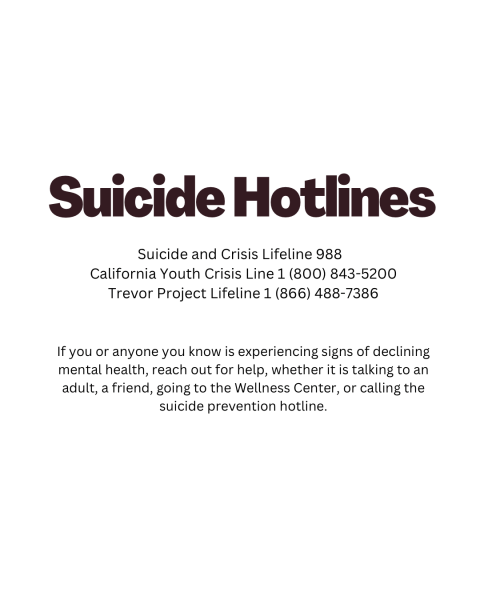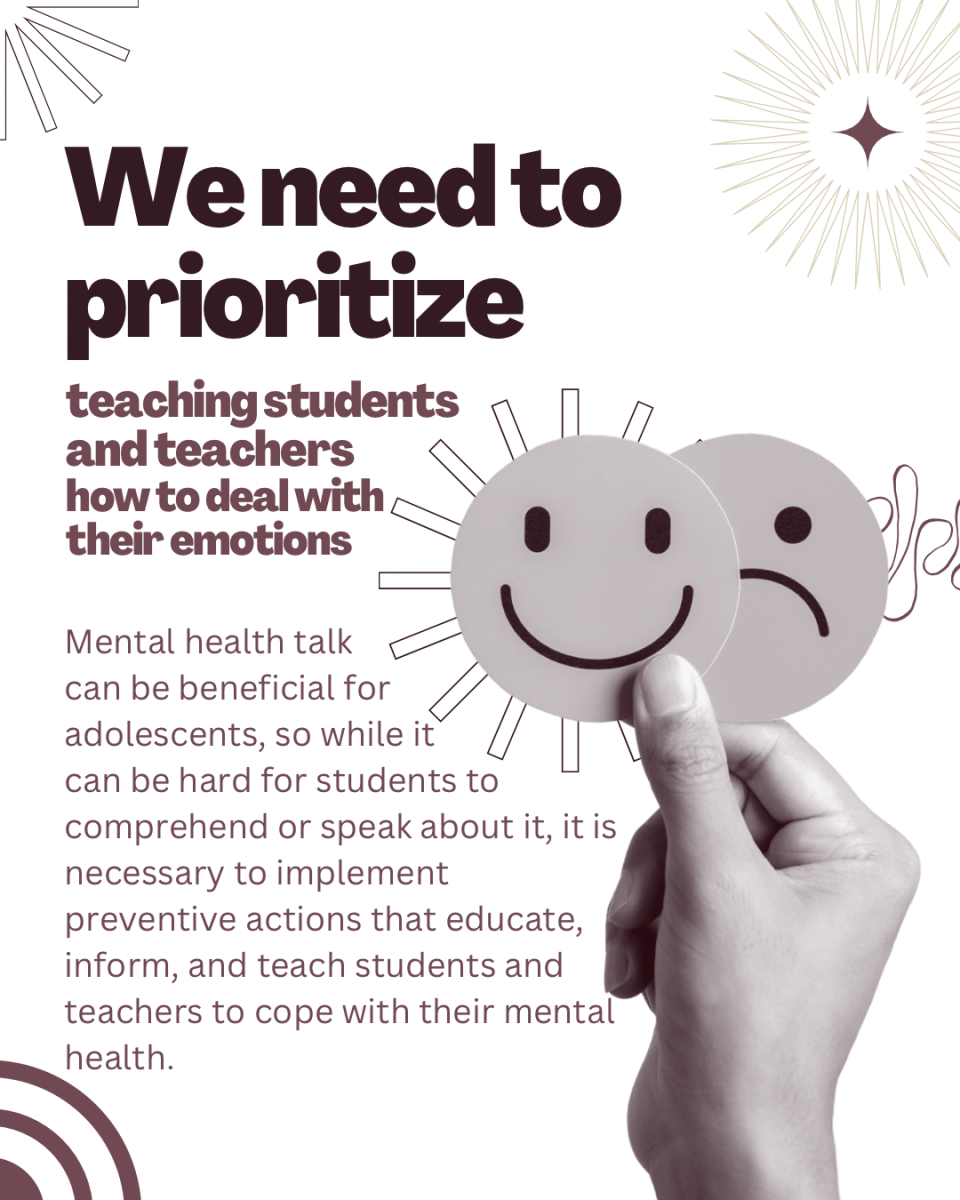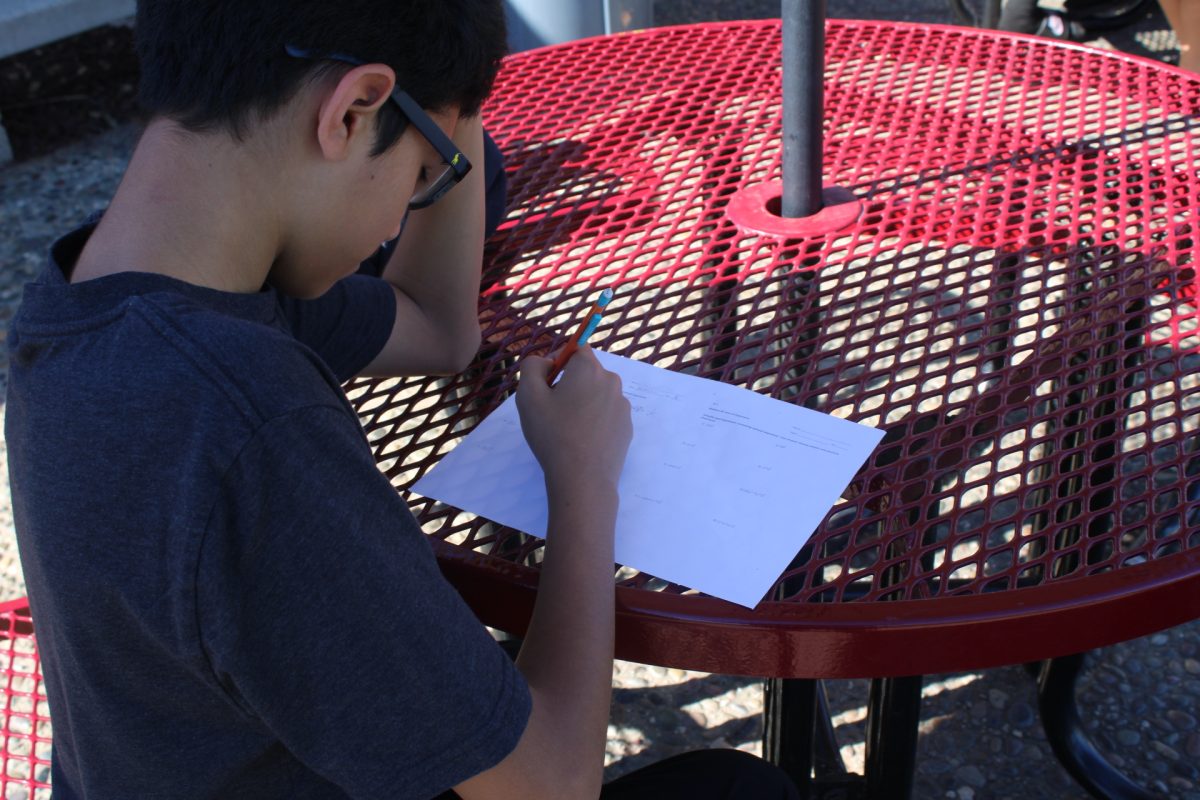Upon return to campus a year after the COVID-19 pandemic began, there was an observable decline in students’ mental health nationwide. According to Columbia University Irving Medical Center, an increase in depressive symptoms and a decrease in mental well-being occurred among adolescents during this time and the National Institute of Mental Health states that youth suicide rates increased. It became regular practice for schools to provide students with information on different mental illness signs, their effects, and the importance of addressing emotions. Although this has been helpful to students, there needs to be a stronger and more proactive approach to helping students in need.
Our campus has followed suit with this practice by implementing mental health assemblies and presentations. Although students have been provided with resources such as Wellness Center, they are often unutilized, and students still struggle to understand their feelings.
“I don’t think kids go to the Wellness Center because I think they’re embarrassed. I think they’re embarrassed to say how they feel, like the problem that they have and they are dealing with,” senior Samantha Garcia said.
Mental health talk can be beneficial for adolescents, so while it can be hard for students to comprehend or speak about it, it is necessary to implement preventive actions that educate, inform, and teach students and teachers to cope with their mental health.
Suicide is one mental health topic that can be hard for students to comprehend or talk about. District personnel presented an informative suicide prevention presentation to all sophomore English classes. The presentation provided resources and preventable actions, and when a student commits suicide, schools abide by a set of district policies and suicide prevention measures to protect students.
Different policies provided by the district office state that school systems are allowed to talk about different mental health issues and provide resources, but bringing up details of a student’s suicide is not safe among other students due to possible suicide contagion.
Headspace National Youth Mental Health Foundation, a foundation that strives to provide early intervention mental health services to people ages 12-25, defines suicide contagion as:
“…the process whereby one suicide or suicidal act within a school, community or geographic area increases the likelihood that others will attempt or die by suicide.”
Schools are impacted by this fear of bringing awareness to suicide and other mental health issues because it leads students to try figuring it out on their own. Teenagers go through many experiences in and out of school that can cause depression, anxiety, and even trauma. Processing difficult emotions and asking for support can be difficult because students are not educated enough about their mental health.
In September, administrators shared mental health resources through on campus, grade-level assemblies in addition to this freshman, junior and senior students got a tour of the Wellness Center along with a mental health presentation with their English classes. This tour and presentation provide resources to seek help if needed.
These preventable actions share resources that can provide help to students. For example, the assemblies and presentations give students 24-hour helplines, counselors’ emails, and available hours for the Wellness Center, but these resources are scarcely used.
In terms of the educational aspect, Peer Counselor and English teacher Jennifer Sun believes that the assemblies and presentations can be helpful for students and provide support, but more importantly, presentations themselves are not enough to establish a connection where students feel encouraged to reach out and ask for help.
“There has to be a way that a student can feel comfortable talking to an adult and getting the helping need, so we don’t ever have to get to this point,” Sun said.
WCUSD Suicide Policy (AR 5141.52), available on the WCUSD district website, outlines preventative actions and the steps that should be taken following a suicide crisis. According to the document:
“The district’s comprehensive health education program shall promote the healthy mental, emotional, and social development of students and shall be aligned with the state content standards and curriculum framework. Suicide prevention instruction shall be incorporated into the health education curriculum at appropriate secondary grades.”
Since 2018, the campus has not offered a health course. Before being removed, the class was one semester long and mandated for every freshman to take, but was cut to make room for Career Technical Education (CTE) pathways. Now, biology does contain some content about health and autonomy, but it does not cover state standards for mental health and sex education as the previous course did.
Mandatory health classes, which include formal mental health education, would help ensure students are educated in these aspects, from how to healthily address their emotional needs to how to seek support when struggling with even the most difficult mindsets, such as contemplating suicide.
Furthermore, while students are given available resources periodically throughout the year, students may look to teachers as a trusted adult to confide in, but teachers and coaches are only trained to refer students to counselors. According to the district document:
“Suicide prevention training shall be provided to teachers, counselors, interns, and other district employees who interact with students, including, as appropriate, substitute teachers, coaches, expanded day learning staff, crossing guards, tutors, and volunteers.”
“Our kids go through so much on the outside and at home in life that people don’t talk about… I think adults need training, I think kids need training, I think everybody needs training,” Sun said.
In order to help students feel comfortable and safe, schools must be proactive about serious topics and be able to at least discuss topics like suicide that affect younger generations. “Proactive” resources WCHS offers are Boost Days that give students a chance to unwind and destress from school work and the Wellness Center that provides a clinical specialist for support.
Principal Charles Park believes that these are two beneficial proactive tools on campus, because they give students time to destress and a way to receive professional help. Looking into both resources, Boost Days are good for some time off. They give students an hour-long lunch to enjoy food trucks and games with friends, but although this time off from school may help a student destress, stress is not the only issue adolescents deal with.
Additionally, the Wellness Center is only open during 4th period and lunch, so in reality, where do students go when they have emotions of depression during 5th period? Must they wait until the Wellness Center opens the next day?
“I think we can always do a better job in providing more resources. I think we have a lot of students who have a lot of challenges, and sometimes they don’t have knowledge of the resources or people at school who they can talk to,” Park said.
The school offers a variety of resources and preventive tools to address students’ mental health, but there needs to be more proactive measures to provide education on different mental health emotions and how to deal with them. One would be to reinstate health class again to all freshmen and another should be to more assemblies throughout the year to further inform students about resources.
If you or anyone you know is experiencing signs of declining mental health, reach out for help, whether it is talking to an adult, a friend, going to the Wellness Center, or calling the suicide prevention hotline.









